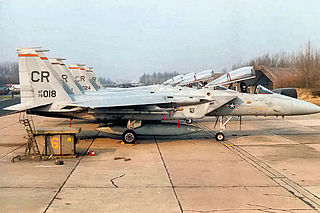This article's lead section does not adequately summarize key points of its contents.(September 2017) |
| 33d Special Operations Squadron | |
|---|---|
 33d Special Operations Squadron General Atomics MQ-9 Reaper 08-0084 | |
| Active | June 12, 1917 – present |
| Country | |
| Branch | |
| Part of | Air Force Special Operations Command |
| Garrison/HQ | Cannon Air Force Base, New Mexico |
| Engagements | World War I World War II 1991 Gulf War Operation Enduring Freedom Operation Iraqi Freedom [1] |
| Decorations | Air Force Meritori9us Unit Award Air Force Outstanding Unit Award [1] |
| Insignia | |
| 33d Special Operations Squadron emblem (approved 13 July 2010) [1] |  |
| 33d Pursuit Squadron emblem (approved 22 September 1933) [2] |  |
The 33d Special Operations Squadron is a United States Air Force unit, assigned to the 27th Special Operations Group, Cannon Air Force Base, New Mexico. The squadron operates the General Atomics MQ-9 Reaper.

The United States Air Force (USAF) is the aerial and space warfare service branch of the United States Armed Forces. It is one of the five branches of the United States Armed Forces, and one of the seven American uniformed services. Initially formed as a part of the United States Army on 1 August 1907, the USAF was established as a separate branch of the U.S. Armed Forces on 18 September 1947 with the passing of the National Security Act of 1947. It is the youngest branch of the U.S. Armed Forces, and the fourth in order of precedence. The USAF is the largest and most technologically advanced air force in the world. The Air Force articulates its core missions as air and space superiority, global integrated intelligence, surveillance, and reconnaissance, rapid global mobility, global strike, and command and control.

The 27th Special Operations Group is the flying component of the 27th Special Operations Wing, assigned to the Air Force Special Operations Command (AFSOC). The group is stationed at Cannon Air Force Base, New Mexico.

Cannon Air Force Base is a United States Air Force Base, located approximately 7 miles (11 km) southwest of Clovis, New Mexico. It is under the jurisdiction of Air Force Special Operations Command (AFSOC). The population of the Cannon AFB CDP was 2,245 as of the 2010 census. The host unit at Cannon is the 27th Special Operations Wing , which activated on 1 October 2007, and is assigned to the Air Force Special Operations Command (AFSOC). The 27 SOW plans and executes specialized and contingency operations using advanced aircraft, tactics and air refueling techniques to infiltrate, exfiltrate and resupply special operations forces (SOF) and provide intelligence, surveillance and reconnaissance and close air support in support of SOF operations.
Contents
- Overview
- History
- World War I
- Inter-war years
- World War II
- Tactical Air Command
- Lineage
- Assignments
- Stations
- Aircraft
- See also
- References
- Notes
- Bibliography
The 33d SOS was named Air Force Special Operations Command’s Special Operations Squadron of the Year for 2012. [3] The squadron was reactivated by the Air Force in May 2009 in direct response to combat needs of today's overseas contingency operations. [4]

Air Force Special Operations Command (AFSOC), headquartered at Hurlburt Field, Florida, is the special operations component of the United States Air Force. An Air Force major command (MAJCOM), AFSOC is also the U.S. Air Force component command to United States Special Operations Command (USSOCOM), a unified combatant command located at MacDill Air Force Base, Florida. AFSOC provides all Air Force Special Operations Forces (SOF) for worldwide deployment and assignment to regional unified combatant commands.

































